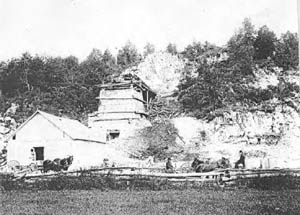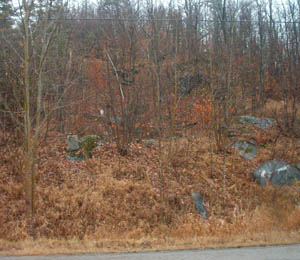Self-Guided Tours — Grants Settlement
|
Click to Print This Page See "Places of Interest" See Map Jamieson Lime Kiln. Grant Settlement RoadDirections
Turn North onto the Grant Settlement Road and proceed 1.2k until you cross the bridge over McNaughton's Creek. Proceed another .2k up the hill. Immediately past the private residence on the left You will see the three cuts in the rock that indicate where the site was. This private property belongs to the residence. HistoryWilliam Jamieson who owned the lime kiln was a man held in high esteem in Ross Township. He was comparatively wealthy and always held some political office. Lime was an important item in the building trades as it was used in every type of mortar for brick and stone wall construction. Mr. Jamieson marketed his lime through a Pembroke concern. Mr. Jamieson hauled the lime to Pembroke with a tandem team of Clydesdales and a huge wagon filled with lime and sometimes a trailer wagon with a second load. Rarely did William Jamieson drive his wagons of lime to Pembroke himself, but when he did, his grooming was faultless as though he were going to church. His beard was always neatly trimmed; he wore cut-a-way or frock coat over black and gray-striped pants and always a gray derby hat He invariably wore tan leather gloves when driving, and a tan duster over his suit
The Jamieson home was half a mile further up the road and right on top of the hill, with a wonderful view of the valley below through which McNaughton creek flowed after taking its tumble over the rock s at Forester's Falls. The Jamiesons had a large home surrounded by shade trees and an attractive flower garden, in summer that garden was filled with blooms of every shade. The Jamieson family was talented, happy and popular. There were three girls, all finished musicians. Marion was the gay one, the life of the party wherever she went an accomplished violinist who also played the piano and harp. She liked to play her violin for home-party square dances and sing the old Scots songs so popular with the old country folk. There were two Jamieson boys, Harry and John. Harry married a neighbour girl and lived on a farm across the road from the old homestead. John took over his father's farm and business and followed in his father's footsteps politically too. He was county treasurer at the time of his sudden death. John married Annie Blakely, daughter of the Rev. M.D.M. Blakely. From the Memoirs of John McLaren McLeese The firing or burning of limestone was an important requirement for chinking and masonry mortar, plaster, and whitewash as soon as improved housing replaced the simple huts of the first pioneers. Methods of burning limestone were minor variations of first breaking the limestone into coarse gravel sizes, usually by sledgehammer, and then layering this material with dry hardwood to fuel the fire, which could not be allowed to die down for as long as twelve days at a stretch. As the lime melted and combined with ash, it was removed from the bottom and additional layers were added at the top. Circular liners of stone, and later cast iron, contained heat and protected the melting lime from contaminants. Adhesive capability of the mortar was resultant from such variables as experience of operators, type and size of limestone chunks, quality of fuel, kiln design, and potency of refreshments occasionally deemed requisite to a task of this nature. Many of these important installations endure in good repair near limestone outcroppings throughout this area. Obscured by undergrowth and obsolete by modern standards, they provide an intriguing perspective of settlers lives. |
 Take Foresters Falls road east out of the village
until you come to the first intersection.
Take Foresters Falls road east out of the village
until you come to the first intersection. Often in the early morning before dawn the people in
Forester's Falls would feel the earth shaking from the blasts set off at the
Jamieson lime-rock mountain. The hill was at the edge of the Grant s settlement
road and the blasting was accomplished early to avoid interference with daytime
traffic. Into the kilns were dumped huge chunks of lime stone to be burned to
white heat by wood fires
Often in the early morning before dawn the people in
Forester's Falls would feel the earth shaking from the blasts set off at the
Jamieson lime-rock mountain. The hill was at the edge of the Grant s settlement
road and the blasting was accomplished early to avoid interference with daytime
traffic. Into the kilns were dumped huge chunks of lime stone to be burned to
white heat by wood fires